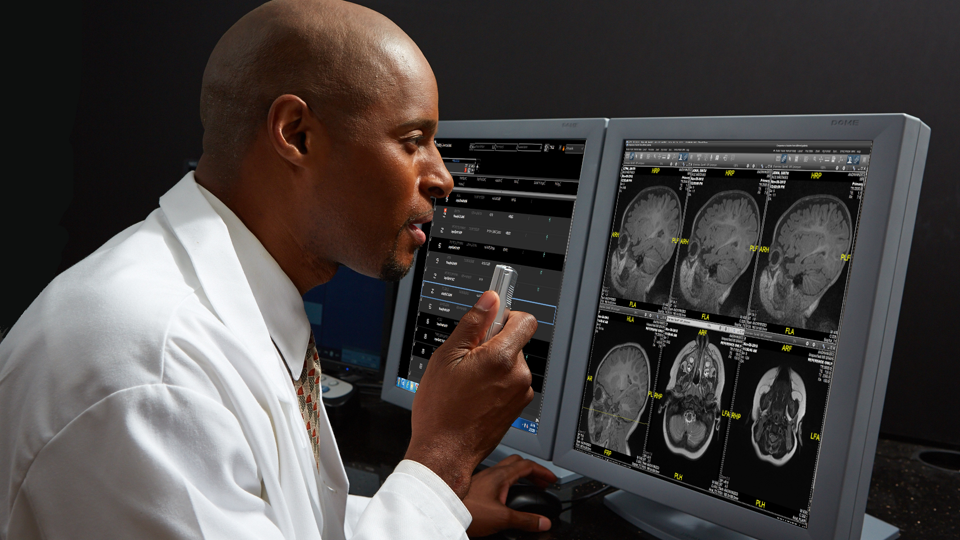Artificial Intelligence Combines with Machine Learning to Bring Greater Efficiency to the Radiology Suite
Two words are at the core of radiology: efficiency and accuracy. Both get a boost from today’s artificial intelligence-driven integrated work systems, and yet far too many practices are still managing with yesterday’s technology. Too often, it comes down to cost, time, and the challenges of integrating new technology with existing hardware. [1]
Intelligent worklist management
Many of the latest technology advances in radiology reading starts with the worklist, the foundation of every radiologist’s day. In many practices, radiologists use a shared list, scrolling through to pick the images they want, with readings prioritized on a first-in, first-out basis rather than the potential findings on the image itself.[2]
Now imagine a system that uses rules-based decision logic to review and prioritize all images, then direct them to the most appropriate subspecialist based on availability. A system that balances the workload based on modality, body part, location, procedure type, and service level agreements.
Even though artificial intelligence can help improve diagnostic accuracy, the information may be useless if the referring physician doesn’t receive that information in a timely manner.
Used properly, such a system could transform the reading workflow, with the potential for significantly reducing report turnaround times, especially critical cases.[1] This is important. For even though artificial intelligence can help improve diagnostic accuracy, the information may be useless if the referring physician doesn’t receive that information in a timely manner. Indeed, the Joint Commission lists timely reporting of critical diagnostic results as a patient safety goal.[3]
More time for patient and clinician interactions
An improved workflow can also clear time for more consultations and patient interactions, as well as open space for additional imaging. In fact, one study found a nearly 30-minute decrease in total interpretation time across all readers of MRI scans when using an analytics-driven worklist.[4] In a 100-radiologist practice, that translates into 50 saved hours a day.
One study found a nearly 30-minute decrease in total interpretation time across all readers of MRI scans when using an analytics-driven worklist.
Time recaptured from non-reading activities is particularly important today given the backlog of imaging due to the pandemic; an aging population that requires more medical services; and radiologist shortages throughout much of the country.[5],[1]
This vision of tomorrow’s worklist is a reality today thanks to GE Healthcare’s CentricityTM Universal Viewer with Autoserve, helping to ensure the right study goes to the right radiologist at the right time.
Want to learn more about the reimagined worklist?
Hear Dr. Elizabeth Bergey’s perspective, President and CEO of Quantum Imaging and Therapeutic Associates, Inc. on the future of the radiology worklist. #radiologychallenge #betterradiologyin60seconds
Join the ‘Better Radiology in 60 Seconds’ challenge for more efficiency stories. Hear from a radiology leader each month about new advances that are positively impacting their practice.
Related Reading
- Hurlen P. Do worklists work? A quantitative approach to the assessment of an Electronic Patient Record function. Stud Health Technol Inform. 2012;180:1015-9
- Baltruschat I, et al. Smart chest X-ray worklist prioritization using artificial intelligence: a clinical workflow simulation. Eur Radiol (2020). https://doi.org/10.1007/s00330-020-07480-7
- Wong TT, Kazam JK, Rasiej MJ. Effect of Analytics-Driven Worklists on Musculoskeletal MRI Interpretation Times in an Academic Setting. AJR Am J Roentgenol. 2019 Feb 26:1-5.
- Orenstein B. In the Flow: Part 1 — New Technology Helps Keep Radiology Work Flowing. Radiology Today. Vol. 19 No. 2 P. 22.
[1] Bassett M. Making the Financial Case for Technology Upgrades. Radiology Business. February 19, 2016.
[2] Baltruschat I, et al. Smart chest X-ray worklist prioritization using artificial intelligence: a clinical workflow simulation. Eur Radiol. 2021. Published online.
[3] The Joint Commission (2020) National Patient Safety Goals. The Joint Commission, United States. Available via http://www. jointcommission.org/standards_information/npsgs.aspx. Accessed February 26, 2021.
[4] Wong TT, Kazam JK, Rasiej MJ. Effect of Analytics-Driven Worklists on Musculoskeletal MRI Interpretation Times in an Academic Setting. AJR Am J Roentgenol. 2019 Feb 26:1-5.
[5] Rosenkrantz AB, Wang W, Hughes DR, Duszak R Jr. A County-Level Analysis of the US Radiologist Workforce: Physician Supply and Subspecialty Characteristics. J Am Coll Radiol. 2018 Apr;15(4):601-606.

